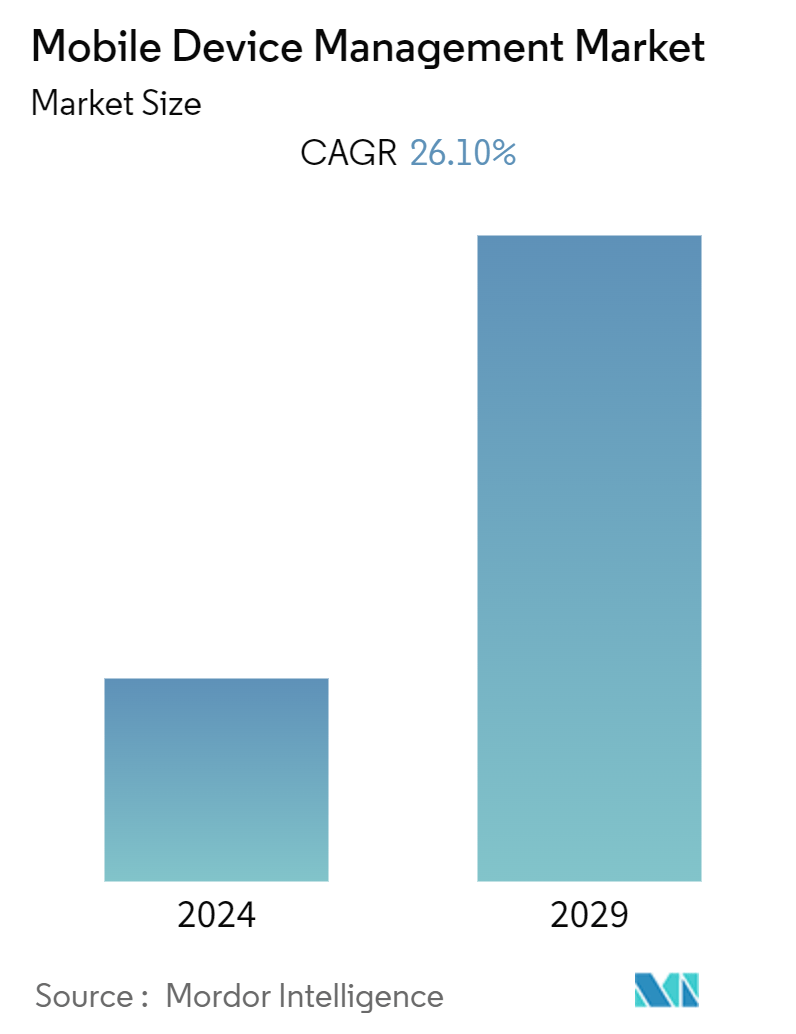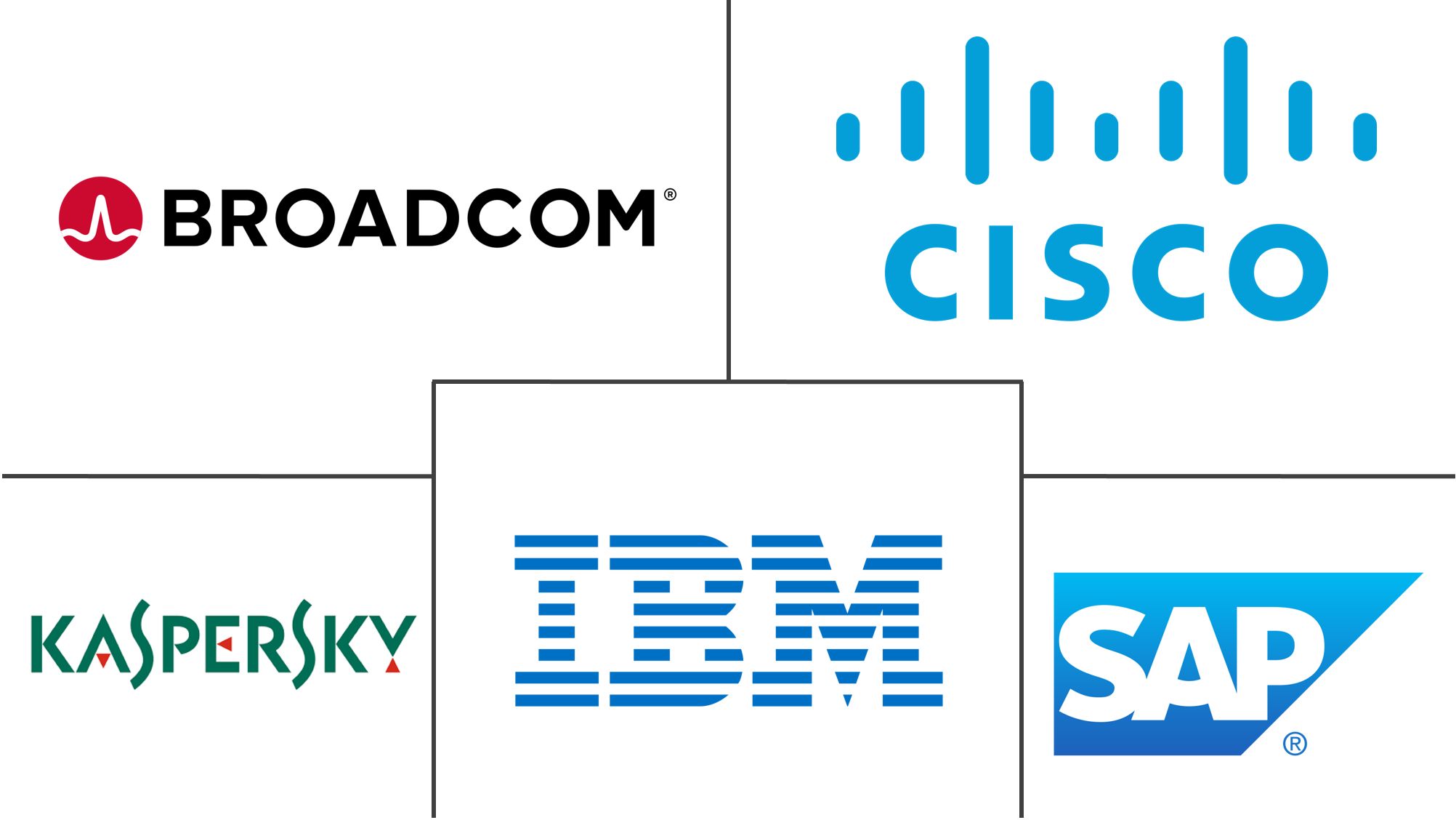
| Study Period | 2019 - 2029 |
| Base Year For Estimation | 2023 |
| Forecast Data Period | 2024 - 2029 |
| CAGR | 26.10 % |
| Fastest Growing Market | Asia Pacific |
| Largest Market | North America |
| Market Concentration | Low |
Major Players
*Disclaimer: Major Players sorted in no particular order |
Mobile Device Management (MDM) Market Analysis
The Mobile Device Management Market is expected to register a CAGR of 26.10% during the forecast period.
Several factors, like the increasing security concerns, the need to manage and secure a growing number of mobile devices, the rising adoption of cloud-based mobile device management solutions, and the growing demand for remote management capabilities, are anticipated to drive the growth of the studied market.
- Mobile devices facilitate employees to conveniently do their work from home, at the office, or on the go. While this offers flexibility and convenience, it could expose an organization to potential threats. Managing mobile devices' security and device health is vital to minimizing an organization's risk posture.
- The rising adoption of Bring Your Device (BYOD) and the growing security concerns to protect an enormous amount of corporate data are significant factors influencing the growth of the MDM market. The proliferation of BYOD has become an apparent force across the business landscape. The rapidly expanding fleet of mobile devices has become an essential consideration for every organization. It drives them to deploy a platform that offers high oversight and robust data protection.
- Devices without the protection of an MDM are at an increased risk of malware and other virus attacks that could compromise the confidential data stored. Any compromise in personal data can permanently affect an organization's reputation with its consumers and other business partners, which is one of the most critical factors driving the market.
- Using low-quality mobile phones can increase the risk of explosions. This is because these phones may use cheap electronic components and lithium-ion batteries that are not adequately tested, leading to overheating and potential explosions. An MDMS system would help in importing genuine mobile devices that meet quality and standards.
- In May 2023, the Nepal Telecommunications Authority introduced the Mobile Device Management System. This security software facilitates the regulator to implement policies that secure, monitor, and manage end-user mobile devices. According to the authority, 27,000 individuals have registered their phones with the MDMS, including registration of the International Mobile Equipment Identity (IMEI) number. This unique 15-digit code precisely identifies the device with the SIM card input.
- Mobile device manufacturers are working toward equipping the devices with built-in 5G components to exploit the full potential of 5G networks. Such efforts are considered to be the key to low latency and high-speed management of the devices. 5G services support various services and associated service requirements across multiple scenarios.
- With 5G expected to reach the enterprise space soon, businesses would need to redesign their enterprise mobility strategies. This is because 5G will increase the adoption of smart devices, wearables, AI, IoT, AR, and VR across industries, therefore, requiring proper management solutions to simplify device management.
- However, the lack of awareness about technological advancements, complexity in implementation and management, compatibility issues with different device operating systems, concerns over data privacy and security, the need for significant IT expertise, and the cost of implementing and maintaining MDM solutions restrain the growth of the studied market.
Mobile Device Management (MDM) Industry Segmentation
Mobile device management (MDM) enables IT teams to control, secure, and enforce policies on smartphones, tablets, and other mobile devices. Mobile device management software is often combined with additional security services and tools, such as mobile application management, to create a complete mobile device and secure enterprise mobility management solution.
The market is segmented by deployment type (on-premise, cloud), end-user vertical (telecom and information technology, BFSI, healthcare, retail, government, manufacturing), and geography (North America, Europe, Asia-Pacific, Latin America, Middle East and Africa) The market sizes and forecasts are provided in terms of value (USD) for all the above segments.
| On-premise |
| Cloud |
| Telecom and Information Technology |
| Banking and Financial Service |
| Healthcare |
| Retail |
| Government |
| Manufacturing |
| Other End-user Verticals |
| North America |
| Europe |
| Asia |
| Australia and New Zealand |
| Latin America |
| Middle East and Africa |
Mobile Device Management Market Size Summary
The Mobile Device Management (MDM) market is poised for significant growth, driven by the increasing need to secure and manage a burgeoning number of mobile devices within organizations. As businesses embrace flexible work arrangements, such as remote and hybrid models, the demand for robust MDM solutions has surged. These solutions are crucial for safeguarding corporate data, especially with the rising adoption of Bring Your Own Device (BYOD) policies. The proliferation of mobile devices necessitates platforms that offer comprehensive oversight and data protection to mitigate risks associated with malware and data breaches. Additionally, the integration of cloud-based MDM solutions is gaining traction due to their scalability, affordability, and ability to streamline device management processes across various industry verticals.
North America stands out as a prominent region in the MDM market, fueled by the increasing demand for advanced technology and the rapid deployment of 5G services. The region's focus on enterprise mobility solutions to manage a dynamic mobile workforce and protect against cyber threats is driving market expansion. Major players in the industry are continuously innovating, with many offering MDM as part of their enterprise mobility management (EMM) solutions. Recent developments, such as partnerships and acquisitions, highlight the competitive landscape, with companies like VMware, Ivanti, and Check Point Software Technologies enhancing their offerings to address the evolving security and management needs of mobile devices. As organizations increasingly recognize the importance of MDM in maintaining data integrity and operational efficiency, the market is expected to witness sustained growth.
Mobile Device Management Market Size - Table of Contents
1. MARKET DYNAMICS
-
1.1 Market Drivers
- 1.1.1 Increasing Adoption of BYOD
- 1.1.2 Growing Security Concerns to Protect Enormous Amount of Corporate Data
-
1.2 Market Restraints
- 1.2.1 High Initial Investment During the Deployment in the Infrastructure
- 1.3 Analysis of Key Criteria for the Selection of MDM Solutions in Enterprises
2. MARKET SEGMENTATION
-
2.1 By Deployment Type
- 2.1.1 On-premise
- 2.1.2 Cloud
-
2.2 By End-user Vertical
- 2.2.1 Telecom and Information Technology
- 2.2.2 Banking and Financial Service
- 2.2.3 Healthcare
- 2.2.4 Retail
- 2.2.5 Government
- 2.2.6 Manufacturing
- 2.2.7 Other End-user Verticals
-
2.3 By Geography***
- 2.3.1 North America
- 2.3.2 Europe
- 2.3.3 Asia
- 2.3.4 Australia and New Zealand
- 2.3.5 Latin America
- 2.3.6 Middle East and Africa
Mobile Device Management (MDM) Market Research FAQs
What is the current Mobile Device Management Market size?
The Mobile Device Management Market is projected to register a CAGR of 26.10% during the forecast period (2025-2030)
Who are the key players in Mobile Device Management Market?
Cisco Systems Inc., SAP SE, Kaspersky Lab Inc., IBM Corporation and Broadcom Inc. (Symantec Corporation) are the major companies operating in the Mobile Device Management Market.


